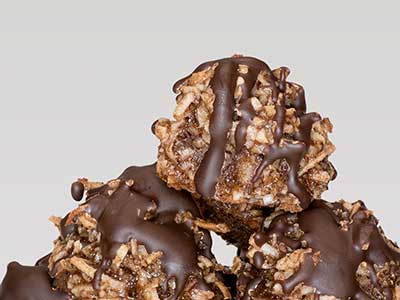July 27, 2015
Mignardise

macarons de noix de coco au chocolat
(coconut-chocolate macaroons)
Here’s a simple question: “How many nickels are in a dollar?” I asked three students that question. Only one was willing to try to answer, and it took him three tries and a hint to get the correct answer. The students had already admitted that they had no idea about simple fractions and couldn’t do decimal math, even with a calculator. These were all adult students. I didn’t ask if they had high school diplomas. There obviously were issues for all three going back to early elementary school days.
I’ve ask similar questions of adult students that don’t come from disadvantaged backgrounds. The nickel question is easy, but doing simple fractions, such as what is one-third of three-quarters, may stump them. An important part of cooking from recipes is being able to convert the quantities as the number of servings change. One student told me that she only uses recipes that exactly fit the number of guests she’s serving.
There are various workarounds that students who cannot do simple fractions use. It’s not unusual to find a student doubling a recipe by measuring everything twice. When they have to halve a recipe, some will measure out the whole and then discard half the ingredients.
Sometimes preparing a recipe for a different quantity involve more concepts than just fractions. There was the student who said he couldn’t double a recipe because the oven couldn’t go as high as seven-hundred degrees. At least his arithmetic was correct.
I may not be able to do calculus, but I can do fractions, factoring, and approximations. I have no conscious memory of learning fractions. That was too long ago. It seems to have always been a part of me. I found a modern paper on the web called Teaching Fractions According to the Common Core Standards that teaches fractions over a period of five years. That’s a lot of attending classes and staying awake, but the contents would be good for all cooks.
Why this sudden desire to write about fractions? Besides having issues arise in classes relative to fractions, the recipe that this mignardise was adapted from is just a fraction of the quantities listed in the original book. The ingredient quantities have been converted to metric measurements and halved. The source is the recent book Chocopologie by Fritz Knipschildt. The original recipe made 10 to 15 chocolate-coconut macaroons. My half-size version makes 16 cookies of a diminutive size.
1 large
egg white
33 g (2-2⁄3 T)
finely granulated sugar
6-1⁄2 g (1 T)
unsweetened cocoa powder
pinch
pinch
80 g (3⁄4 c)
sweetened, shredded coconut
60 g (2 oz)
chocolate, 72% cocoa mass
1. Preheat your oven to 180 °C (355 °F).
2. Whisk the egg white, sugar, cocoa powder, and salt together. Stir in the shredded coconut.
3. Using a 1 tablespoon scoop, drop mounds of the dough onto a rimmed baking sheet lined with a silicone-rubber liner. Using dampened hands, roll each mound into a ball, and arrange on the baking sheet.
4. Bake the macaroons until lightly browned, about 12 minutes. Make sure the egg white that seeps out around the edges is fully cooked.
5. Rest the macaroons on their baking sheet for about 10 minutes to firm-up. Then transfer them to a cooling rack set over a parchment-paper lined baking sheet.
6. When the cookies are fully cooled, melt the chocolate over simmering water. Drizzle the melted chocolate over the cookies.
7. Leave the cookies on the cooling rack until the chocolate cools and hardens completely.
© 2015 Peter Hertzmann. All rights reserved.
